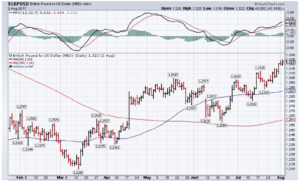The Bank of England convened for its highly anticipated Super Thursday meeting on August 3, 2017. At the conclusion of the meeting, MPC members voted by margin of 6:2 to maintain the current bank rate of 0.25%. BOE members cited concerns about UK economic growth prospects for the remainder of 2017, and tempered expectations of strong growth from a prior forecast of 1.9% to 1.7% for the current year. At the time of writing, the GBP/USD was trading at 1.3141, down 0.64% or $0.0083. The 52-week trading range for the cable is 1.1841 on the low end and 1.3445 on the high-end.
Pound Slides but Remains Above Critical 1.31 Level
For GBP bulls, optimism remains however. Weiss Finance trading expert, Kevin Leery indicated there is no reason for alarm yet, ‘The current value of the cable is markedly higher than the 200-day moving average of 1.261, and the 50-day moving average of 1.291. More importantly, the GBP/USD pair remains above the critical 1.30 level – considered by many to be a key resistance level for the pound. For the year to date, the currency pair has generated an impressive 6.46% return.’
Â
The decision on Super Thursday dropped the GBP from 1.3243 to 1.3171 instantly, before it plunged towards 1.3115 and then started reversing. The GBP slid from an 11-month high against the USD, while UK government bonds gained traction with investors. The decision to maintain the bank rate at 0.25% has far-reaching implications for the UK economy.
The GBP also hit its lowest level against the EUR for the year, as speculators shorted the sterling en masse. The consensus among currency traders is that a rate hike is less likely in August 2018, and more possible in November 2018. 2 factors in the MPC decision weighed heavily on trading activity:
- 6:2 vote in favour of maintaining the bank rate (the prior vote was 5:3)
- Economic growth forecasts were revised lower from 1.9% to 1.7% in 2017
Viewed together, these decisions paint a poor picture for growth prospects. GBP-induced inflation is weighing on the consumption patterns in the UK economy. We are seeing rising prices and falling real wages – reasons for concern. Evidence of this is the elevated level of the FTSE 100 index. Since some 70% of the revenue streams generated on the FTSE 100 index are foreign-based, a weak GBP is favourable when currencies are exchanged.
Weak Sterling Affects Trader Sentiment
Further, UK exporters benefit from a weak sterling since foreign buyers can purchase more per unit of their currency. Following Super Thursday’s decision, the EUR/GBP pair gained 0.8% at 0.9041. The next move for the GBP/USD could be 1.3100, and this will be a critical level for currency traders and speculators.
The vaunted 1.3250 resistance level is now firmly in the distance, and caution is the order of the day. The UK’s GDP annual growth rate reflects declining performance quarter on quarter in July 2017. In January, the UK annual GDP growth rate was 1.9%, followed by 2% in March, and 1.7% in July.
Across the Atlantic, the US dollar is slowly recovering. The dollar index spot (DXY) was trading at 92.768 (Thursday, August 3, 2017), down marginally on the day, but above the 52-week low figure of 92.548. On the high-end, the DXY hit 103.820. The year to date return on the US dollar index is -9.24% – in line with the performance of the USD.
ISM data in the US indicates that the US services sector grew at its lowest pace in 11 months. It plunged from 57.4 in June 2017 to 53.9 in July, as analysts were expecting a level of 57. This naturally affected the USD and the DXY to the downside.
Â


{ 0 comments… add one now }